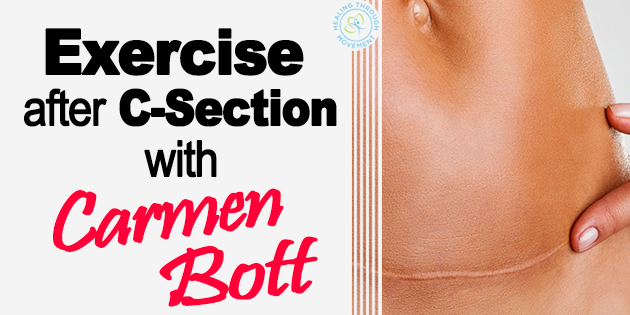Hey this is Rick Kaselj from exercisesforinjuries.com. Today, I have another interview with a fitness professional and we will talk about injuries and exercises. We will focus on C-section. I am going to get Carmen, who is the expert person that I am going to interview today to introduce herself and we’ll get into the interview.
Carmen Bott: Alright, thank you very much Rick. My name is Carmen Bott. I have a Masters Degree in Exercise Science from the University of British Columbia. I teach for Secondary level there and teach in college here in Vancouver. I also own a company called HumanMotion.com and we train lead attitude as our trademark. So we do a little bit of everything.
Rick Kaselj: Ok. So today we are going to talk about C-Section. I know a couple of years ago you probably won’t even be thinking about it but now you are thinking about it so maybe you can explain your story and why you want to talk about this topic.

Carmen Bott: Absolutely, yeah of course any pregnant women assume that they are going to go through a natural labor and natural birthing process. My husband and I had gone to a couple of workshops on water bursting and this and that and we had all things planned out. But Jackson, our son, he is now seven months, decided that he would be breeched.
When a baby is breech you have the option of going in for a procedure called an ECV which essentially is an external cephalic version. Cephalic means head, head is up so we are trying to rotate the baby and they can do that manually from the outside. So you got two very strong OB GYN on the other side of your tummy. And they actually monitor the baby. While they do the procedure they attempt to turn the baby.
So we went through that apparently I now hold a record in the medical hospital for the longest ECV which is very painful and my son was turned about 95% of the way there. Then we went out the next day and he turned back to where he wanted to be which is head up and over on the left side.
We decided that the baby probably knows best and you do have the option of giving birth naturally with a breech baby at women’s hospital in Vancouver British Columbia where they got some specialists there. But the risk, in my mind, is not really worth it and this is my first baby.
So we decided to opt for what we called the “Hollywood option” which is the schedule C-Section which is I am very unhappy about because I trained throughout my entire pregnancy with weights, kettle bells, push-leg, you name it.
I also played football up to 14 weeks, sounds very active. I didn’t really like the idea of having a surgery and then having an eight weeks recovery period and potentially having complications with the muscular maternal area, post surgery.
It wasn’t ideal but we have to do what is safe and what we are comfortable with as well. We went ahead with it and I looked out and had a good surgeon. Then I had the C-Section, the delivery went very smoothly and my son was very healthy when he was born.
There’s a little bit of complication in the end of the surgery. When they sewed me back up on the left side they actually ended tying up a bunch of nerves. So I had a nerve bundle impingement from the stitches.
I couldn’t get out of bed for three days. Because of that, they brought in an anesthesiology team and did a nerve block which is where they injected an anesthetic with the transverse abdominal wall through the different layers of tissue and the multi muscular tissue and freeze the area just to block the pain.
It worked and it alleviated some of the pain which is a lot more painful than I had expected because of the complication. But I later found out that because of my background and all of the trainings I had done the stasha was so tight that when they cut me open it actually sprung back and they really had to tugged on it to get it back to where I should be with so many backups.
So opposed to being fit and strong that was unfortunate but the good news was because I was in good physical condition and healthy, the actual recovery was quick. So I was able to get up and walk around once the stitches dissolved and haven’t had any complications after that.
Rick Kaselj: Ok. You are saying that you were quite active prior to delivery, what are some recommendations you would have for people like the fitness professionals or even to the general public when it comes to exercising while pregnant.

Carmen Bott: Well, that’s thing you have to be careful and just follow the obstetric guidelines which they haven’t done a lot of research on strength training. Most of the researches have been done on physical responses to cardiovascular exercise. What they have found is that the old adage of don’t go over a 140 beeps per minute is now null and void.
They are saying that if you were active and you get exercises at a high intensity you can do that while pregnant. Use the talk test.
One piece of advice I would give and this is based on a research done by Dr. Clapp who is a Physician in the State who studied about 500 active athletic women. These weren’t women who were walking and doing yoga, these were athletes that he actually evaluated while they were pregnant and monitored the fetus as well with response to the exercise and one thing he did that he looked at was called the Fetal Kick Count.
As long as the baby is active after a session that’s a good sign. Take your time period after training and set your timer for 10 minutes, you’d count number of fetal kicks on movement in that time. And you basically make sure that each time you train that there are roughly the same amount so that would be the standard for that baby, because every baby is different.
So my baby was active, he is always active after training. I also just used RPE so making sure if I felt dizzy, if I felt tired, it was not a day to push it. People say that you are tired on the first trimester, I would disagree. I think you are tired if you are used to being very active and very fit and feeling good I think you will be tired for the whole 10 months, the whole 9 months.
Just listen to your body is number one but you can if you are use to it. You can push the limits cardiovascular wise as long as you monitor the baby’s well-being with kick counts and use the talk test or RPE.

It’s not the time to do personal best or time to go to level 9 or 10 on an RPA test. It’s a time to make sure that you are healthy and the baby is healthy. Essentially you are training the baby in utero. When my son was born he’s resting heart rate was 30 beeps slower than average. So there’s a possibility he could have been trained while he was in utero, that’s kind of interesting.
Thanks so much Carmen.
This is the first part of the interview, I will be back again with the second part.
Her are some other articles that my interest you:
- Top 5 Exercise Considerations for Postpartum Weight Loss by Sara Dean
- A Quick Guide to Safe Exercising After a C section with Jago Holmes
Rick Kaselj, MS
.
